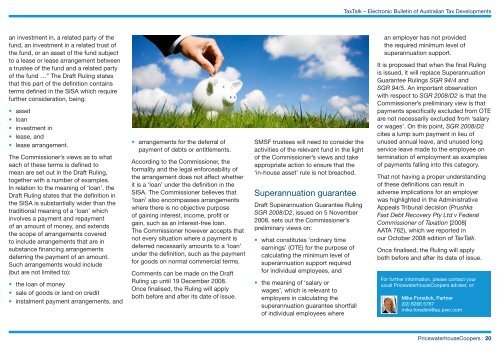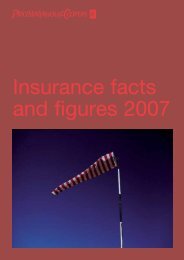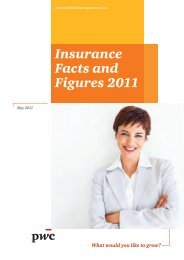Thin capitalisation: eroding asset values and increasing debt ... - PwC
Thin capitalisation: eroding asset values and increasing debt ... - PwC
Thin capitalisation: eroding asset values and increasing debt ... - PwC
Create successful ePaper yourself
Turn your PDF publications into a flip-book with our unique Google optimized e-Paper software.
TaxTalk – Electronic Bulletin of Australian Tax Developments<br />
an investment in, a related party of the<br />
fund, an investment in a related trust of<br />
the fund, or an <strong>asset</strong> of the fund subject<br />
to a lease or lease arrangement between<br />
a trustee of the fund <strong>and</strong> a related party<br />
of the fund …” The Draft Ruling states<br />
that this part of the definition contains<br />
terms defined in the SISA which require<br />
further consideration, being:<br />
•<br />
•<br />
•<br />
•<br />
•<br />
<strong>asset</strong><br />
loan<br />
investment in<br />
lease, <strong>and</strong><br />
lease arrangement.<br />
The Commissioner’s views as to what<br />
each of these terms is defined to<br />
mean are set out in the Draft Ruling,<br />
together with a number of examples.<br />
In relation to the meaning of ‘loan’, the<br />
Draft Ruling states that the definition in<br />
the SISA is substantially wider than the<br />
traditional meaning of a ‘loan’ which<br />
involves a payment <strong>and</strong> repayment<br />
of an amount of money, <strong>and</strong> extends<br />
the scope of arrangements covered<br />
to include arrangements that are in<br />
substance financing arrangements<br />
deferring the payment of an amount.<br />
Such arrangements would include<br />
(but are not limited to):<br />
•<br />
•<br />
•<br />
the loan of money<br />
sale of goods or l<strong>and</strong> on credit<br />
instalment payment arrangements, <strong>and</strong><br />
• arrangements for the deferral of<br />
payment of <strong>debt</strong>s or entitlements.<br />
SMSF trustees will need to consider the<br />
activities of the relevant fund in the light<br />
of the Commissioner’s views <strong>and</strong> take<br />
appropriate action to ensure that the<br />
‘in‐house <strong>asset</strong>’ rule is not breached.<br />
According to the Commissioner, the<br />
formality <strong>and</strong> the legal enforceability of<br />
the arrangement does not affect whether<br />
it is a ‘loan’ under the definition in the<br />
SISA. The Commissioner believes that<br />
‘loan’ also encompasses arrangements<br />
where there is no objective purpose<br />
of gaining interest, income, profit or<br />
gain, such as an interest-free loan.<br />
The Commissioner however accepts that<br />
not every situation where a payment is<br />
deferred necessarily amounts to a ‘loan’<br />
under the definition, such as the payment<br />
for goods on normal commercial terms.<br />
Comments can be made on the Draft<br />
Ruling up until 19 December 2008.<br />
Once finalised, the Ruling will apply<br />
both before <strong>and</strong> after its date of issue.<br />
Superannuation guarantee<br />
Draft Superannuation Guarantee Ruling<br />
SGR 2008/D2, issued on 5 November<br />
2008, sets out the Commissioner’s<br />
preliminary views on:<br />
• what constitutes ‘ordinary time<br />
earnings’ (OTE) for the purpose of<br />
calculating the minimum level of<br />
superannuation support required<br />
for individual employees, <strong>and</strong><br />
• the meaning of ‘salary or<br />
wages’, which is relevant to<br />
employers in calculating the<br />
superannuation guarantee shortfall<br />
of individual employees where<br />
an employer has not provided<br />
the required minimum level of<br />
superannuation support.<br />
It is proposed that when the final Ruling<br />
is issued, it will replace Superannuation<br />
Guarantee Rulings SGR 94/4 <strong>and</strong><br />
SGR 94/5. An important observation<br />
with respect to SGR 2008/D2 is that the<br />
Commissioner’s preliminary view is that<br />
payments specifically excluded from OTE<br />
are not necessarily excluded from ‘salary<br />
or wages’. On this point, SGR 2008/D2<br />
cites a lump sum payment in lieu of<br />
unused annual leave, <strong>and</strong> unused long<br />
service leave made to the employee on<br />
termination of employment as examples<br />
of payments falling into this category.<br />
That not having a proper underst<strong>and</strong>ing<br />
of these definitions can result in<br />
adverse implications for an employer<br />
was highlighted in the Administrative<br />
Appeals Tribunal decision (Prushka<br />
Fast Debt Recovery Pty Ltd v Federal<br />
Commissioner of Taxation [2008]<br />
AATA 762), which we reported in<br />
our October 2008 edition of TaxTalk.<br />
Once finalised, the Ruling will apply<br />
both before <strong>and</strong> after its date of issue.<br />
For further information, please contact your<br />
usual PricewaterhouseCoopers adviser, or:<br />
Mike Forsdick, Partner<br />
(02) 8266 5767<br />
mike.forsdick@au.pwc.com<br />
PricewaterhouseCoopers : 20
















